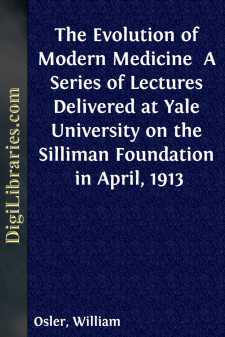Categories
- Antiques & Collectibles 13
- Architecture 36
- Art 48
- Bibles 22
- Biography & Autobiography 813
- Body, Mind & Spirit 141
- Business & Economics 28
- Children's Books 12
- Children's Fiction 9
- Computers 4
- Cooking 94
- Crafts & Hobbies 4
- Drama 346
- Education 46
- Family & Relationships 57
- Fiction 11826
- Games 19
- Gardening 17
- Health & Fitness 34
- History 1377
- House & Home 1
- Humor 147
- Juvenile Fiction 1873
- Juvenile Nonfiction 202
- Language Arts & Disciplines 88
- Law 16
- Literary Collections 686
- Literary Criticism 179
- Mathematics 13
- Medical 41
- Music 40
- Nature 179
- Non-Classifiable 1768
- Performing Arts 7
- Periodicals 1453
- Philosophy 64
- Photography 2
- Poetry 896
- Political Science 203
- Psychology 42
- Reference 154
- Religion 513
- Science 126
- Self-Help 83
- Social Science 81
- Sports & Recreation 34
- Study Aids 3
- Technology & Engineering 59
- Transportation 23
- Travel 463
- True Crime 29
The Evolution of Modern Medicine A Series of Lectures Delivered at Yale University on the Silliman Foundation in April, 1913
by: William Osler
Description:
Excerpt
INTRODUCTION
SAIL to the Pacific with some Ancient Mariner, and traverse day by day that silent sea until you reach a region never before furrowed by keel where a tiny island, a mere speck on the vast ocean, has just risen from the depths, a little coral reef capped with green, an atoll, a mimic earth, fringed with life, built up through countless ages by life on the remains of life that has passed away. And now, with wings of fancy, join Ianthe in the magic car of Shelley, pass the eternal gates of the flaming ramparts of the world and see his vision:
Below lay stretched the boundless Universe!
There, far as the remotest line
That limits swift imagination's flight,
Unending orbs mingled in mazy motion,
Immutably fulfilling
Eternal Nature's law.
Above, below, around,
The circling systems formed
A wilderness of harmony.
(Daemon of the World, Pt. I.)
And somewhere, "as fast and far the chariot flew," amid the mighty globes would be seen a tiny speck, "earth's distant orb," one of "the smallest lights that twinkle in the heavens." Alighting, Ianthe would find something she had probably not seen elsewhere in her magic flight—life, everywhere encircling the sphere. And as the little coral reef out of a vast depth had been built up by generations of polyzoa, so she would see that on the earth, through illimitable ages, successive generations of animals and plants had left in stone their imperishable records: and at the top of the series she would meet the thinking, breathing creature known as man. Infinitely little as is the architect of the atoll in proportion to the earth on which it rests, the polyzoon, I doubt not, is much larger relatively than is man in proportion to the vast systems of the Universe, in which he represents an ultra-microscopic atom less ten thousand times than the tiniest of the "gay motes that people the sunbeams." Yet, with colossal audacity, this thinking atom regards himself as the anthropocentric pivot around which revolve the eternal purposes of the Universe. Knowing not whence he came, why he is here, or whither he is going, man feels himself of supreme importance, and certainly is of interest—to himself. Let us hope that he has indeed a potency and importance out of all proportion to his somatic insignificance. We know of toxins of such strength that an amount too infinitesimal to be gauged may kill; and we know that "the unit adopted in certain scientific work is the amount of emanation produced by one million-millionth of a grain of radium, a quantity which itself has a volume of less than a million-millionth of a cubic millimetre and weighs a million million times less than an exceptionally delicate chemical balance will turn to" (Soddy, 1912). May not man be the radium of the Universe? At any rate let us not worry about his size. For us he is a very potent creature, full of interest, whose mundane story we are only beginning to unravel.
Civilization is but a filmy fringe on the history of man. Go back as far as his records carry us and the story written on stone is of yesterday in comparison with the vast epochs of time which modern studies demand for his life on the earth....


